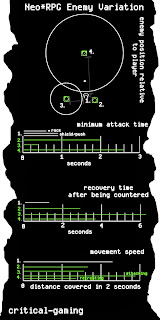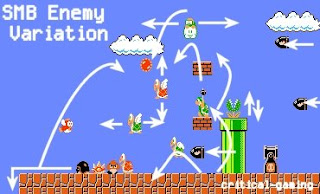Mario Melodies: Variation part.3
 Monday, June 23, 2008 at 9:22PM
Monday, June 23, 2008 at 9:22PM Over the last week, I've covered strict variation thoroughly. By defining, isolating, and comparing similar sections from a game, trends of game mechanic influences and how these trends are created can be deduced. In this method of analysis, keeping the distinct sections in chronological or "game order" becomes increasingly difficult the less linear the game to be examined is. Fortunately open variation isn't bound by such limiting criteria.
Open variation is examining how any combination of game elements differ from one another. The analyst is free to group and compare any number of game elements and how they influence the game's mechanics. Naturally, this freedom will lead to the creation of combinations that may not exist in the game world. That's perfectly fine. This method is well suited for analyzing groups of similar game elements like enemies. Take Neo*RPG's enemies for example.
The order of mechanics in Neo*RPG are....
- 1. Throw Rock, Shield, Push
- 2. Move
Because spacing (or positioning) is very important in Neo*RPG (and there is a significant amount of interplay/interaction between the player, enemies, and level elements) the important factors to consider consist of movement speed, relative position, attack speed, and recovery speed.
- Starting at the top, as you can see the positioning of the enemies relative to the player is unique between each type of enemy making up the close, medium, and long range positions.
- The player has some of the fastest offensive and defensive moves. This only makes sense. The player should have some advantage over the environment and enemies. The degree of imbalance in the player's abilities sets the pace of the game.
- Enemy.2 can't attack a second time faster than the player can recover from the first hit. The gap between the player's recovery time and the enemies attack time is offset enough so that other enemies can fill it in. Strength in numbers.
- Enemy.3 has the fastest attack speed at close range. However, it has a long recovery time when it is countered and pushed outside of its defensive circle.
- Though Enemy.4 has the greatest attack range, movement speed (when attacking) its slow retreating speed and large counter area (moving inside its circle) creates a need for other enemies to keep the player from countering it so easily. Also, because the rocks it throws can't hurt other enemies, enemy.4 has the only attack that can circumvent limitations of physical enemy bodies like enemy.2 and enemy.3.
The chart shows that every enemy has a unique way to move, attack, and recover from being attacked. Because of the enemies' variety and unique abilities, they are highly adaptive. Because the player and the enemies attack, move, and recover at different rates that are balanced offensively and defensively, it's clear that the variation designed in the enemies complement each other fitting together snugly.
Open variation doesn't need to be a complex as my Neo*RPG example. For a game like Super Mario Bros., the enemy attacks, and counters are all tied into their position and movement. So, representing the variation in the enemy design is as simple as drawing up this chart. For this example, I only picked the land enemies.
- The Buzzy Beetle, Spiny, Goomba, and Koopa all walk along the ground. However, the Spiny can't be jumped on (or bumped from underneath). Only a fireball will do away with this pest. The Goomba is easily squashed, while the Buzzy Beetle and the Koopa retreat into their shells for protection. The difference between the later two is that the Red Koopa turn around instead of walking off platforms or into pits.
- The Para Koopa each have a different pattern of motion taking up a unique space that only those who can defy gravity can hold.
- The Lakitu hangs out high in the sky throwing down Spinys to make Mario's life miserable. No other enemy sticks so religiously out of reach as this one. Its height gives it the freedom to follow Mario through a level.
- The Piranha Flowers turn useful platforms into dangers.
- The Cheep-Cheep and the Bullet Bills have a unique way of moving all to themselves. Unlike most of the other enemies, these guys can pass right through the solid elements of a level. The arc of flight the Cheep-Cheep takes depends on Mario's position and speed. But once they go up, their timing and path is set. The Bullet Bills can travel with Mario through the remainder of a stage in a straight path.
- Finally, the Hammer Bros. These guys can jump up (or down) through brick platforms. The arc of the flying hammers are tricky and unpredictable. These guys often are found in pairs. Two of them working together can set up quite an impassable wall against Mario.
Just stand back (or sit back) and look at the diagram. The whole area is filled up. Each enemy has a unique combination of movement and counters. After all, why design an enemy that is a copy of another? What function would it have?
It's important to keep a game's mechanics in mind when looking for variation. How the changing arrangements of a game's elements shape the player's choices (gameplay) is what variation is all about.
That wraps up variation. We've spent over a week talking about mechanics, interplay, and variation all in efforts to prepare for what's coming up next. Counterpoint is on the horizon.



